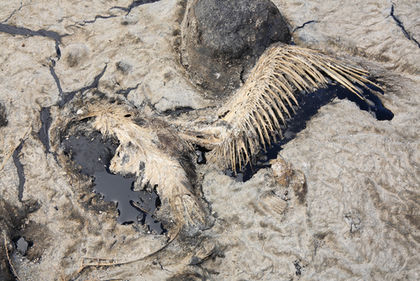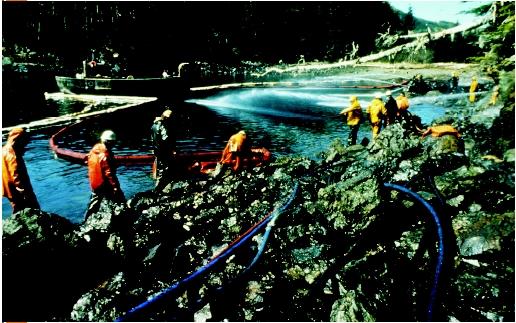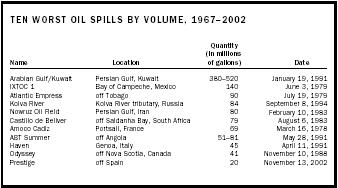Disasters: Oil Spills

Liquid petroleum (crude oil and its refined products such as tar, lubricating oil, gasoline, and kerosene) can be released as catastrophic spills from point sources (e.g., from tankers and blowouts) or as chronic discharges typically from nonpoint sources (e.g., from urban runoff or fallout from the atmosphere). Releases of petroleum into the environment occur naturally from seeps as well as from human sources. Together natural and human sources contribute about 380 million gallons of petroleum to the oceans each year. Of this, about 45 percent comes from natural seeps, and the remainder may be attributed to the human activities of petroleum production, transportation, and consumption. Discharges during petroleum production tend to be restricted to areas of exploration and extraction and are mostly due to the release of "produced waters" (water extracted with petroleum from the reservoir); these discharges contribute about 5 percent of the petroleum reaching the sea from human sources. Spills during the transport, refinement, and distribution of petroleum are most common along shipping routes and pipelines and make up about 22 percent of human-caused petroleum inputs. Spills during petroleum consumption (i.e., use of automobiles, boats, etc.) tend to be small but are so numerous and widespread that they contribute the vast majority (about 70 percent) of human-caused petroleum pollution in the sea. Therefore, consumers could make an enormous contribution to pollution prevention through proper use of petroleum products in vehicles and other personal equipment maintained to avoid leaks and spills.
The effects of spilled petroleum on marine organisms can be lethal or sublethal. Lethal effects are often obvious after large spills, with the most attention focused on birds and mammals (e.g., 900 bald eagles, 250,000 seabirds, 2,800 sea otters, and 300 harbor seals were killed directly by the Exxon Valdez spill), but population-level consequences are difficult to measure. Considerable controversy arises in the determination of when populations have recovered. Even when organisms are not killed, oil fouling can reduce feeding efficiency, growth and reproductive rates, survival of offspring, and resistance to diseases. Petroleum may act synergistically with other pollutants, such as those found in urban runoff, to cause even more toxic effects like high rates of mortality or reproductive failure. Petroleum can kill birds and mammals by reducing the capacity of feathers and fur to keep the animals warm, or through ingestion when birds and mammals attempt to remove the petroleum or eat fouled prey.
The largest oil spill in history occurred from tankers, a tank field, offshore terminals, and refineries during the 1991 Persian Gulf War; it dwarfed other spills with a release of approximately 520 million gallons of oil. This was more than three times the volume of the second-largest spill, from the IXTOC 1 blowout in the Gulf of Mexico in 1979. The 1989 spill of eleven million gallons of crude oil from the Exxon Valdez along 1,100 miles of Alaska's pristine southern coast was the largest spill in U.S. history and approximately the fortieth-largest spill globally. It caused a national backlash against "big oil" in the United States and led to the passage of the 1990 Oil Pollution Act. This legislation creates a cooperative arrangement between the polluter and the resource trustee in order to increase the speed and effectiveness of cleanup efforts and reduce the intensity of litigation.
Oil spills from tankers capture the most media attention, but, as of 2000, ships contributed less than 2 percent of petroleum in the oceans. This is dwarfed by the 45 percent input from natural seeps. However, seeps typically release oil at a slow constant rate and the surrounding ecosystems have adapted to the presence of oil (although species diversity is reduced), with microorganisms even using the oil as a source of energy. Tanker spills, on the other hand, often occur in ecologically sensitive near-shore areas and the volume of oil released at once can be significant. The largest human source of petroleum in the marine environment is the consumer, from sources such as personal watercraft (especially two-stroke engines), automobiles, fuel jettisoned from aircraft, and municipal waste, the sum of which aggregates into urban runoff, wastewaters, river discharge, and atmospheric deposition. These inputs are most pronounced in near-shore areas, which also have the most sensitive ecosystems (e.g., estuaries, mangrove forests, coral and oyster reefs, coastal marshes, sea grass, and kelp beds). These ecosystems derive much of their physical structure from the organisms themselves; as such, mortality due to petroleum can destroy the physical structure, leading to erosion of underlying sediments and the collapse of the ecosystem.
Current technology is insufficient to clean up large spills. Techniques in use include mechanical containment with booms and recovery with skimmers, suction equipment and sorbent materials, chemical treatment with dispersing and gelling agents, and physical removal via wiping, pressure washing, and raking. Scientists are developing bacterial strains to devour petroleum in spills and fertilizers to stimulate the success of these bacteria in the sea; although promising, this technique remains insufficient. A 20 percent recovery of spill volume is considered a good effort. Some cleanup efforts may do more harm than good. For example, the hot water scouring of beaches following the Exxon Valdez spill stripped silt from between rocks and thereby prevented recolonization by bivalves, which must wait until sediments are naturally replenished. Some of the chemical agents are toxic themselves, and a number, such as gelling agents , must be applied at several times the volume of the spill itself, clearly impractical for a spill of millions of gallons.

It is still the case that most petroleum spilled is "cleaned" by natural processes or remains for decades in the environment in forms such as tarballs accumulated on shorelines or petroleum soaked deeply into shoreline gravel. Natural cleansing of petroleum in water, particularly light oils, occurs through evaporation (10 to 75 percent during the first few days, depending on petroleum weight and environmental conditions), photooxidation, and microbial degradation by bacteria, fungi, and heterotrophic phytoplankton . A small amount dissolves in the water, but this increases the toxicity of the water to organisms, and petroleum suspended in water may attach to suspended sediments that eventually settle to the sea floor, from where the petroleum may be rereleased into the water.
The monetary costs of petroleum spills vary tremendously, even for identical spill volumes, depending on the sensitivity of the local ecosystem, type of petroleum released, weather, ocean currents and waves, time of year, use of local beaches, local fishing activity, presence of ecological reserves, containment and cleanup effectiveness, and many other factors. The financial responsibility for the spill lies with the polluter, but the cost of a petroleum spill is open to interpretation and often spawns litigation.
Spills from vessels in U.S. waters declined significantly during the 1990s (less than one-third of total spillage in the 1980s) due to better-designed ships (e.g., double-hull tankers and new construction materials being phased in) and more stringent regulations and operational practices. This decline in spills occurred at the same time as the global tanker fleet grew slightly to 7,270 in 1999, but by that year more than half of the fleet was less than fifteen

| Name | Location | Quantity (in millions of gallons) | Date |
| Arabian Gulf/Kuwait | Persian Gulf, Kuwait | 380–520 | January 19, 1991 |
| IXTOC 1 | Bay of Campeche, Mexico | 140 | June 3, 1979 |
| Atlantic Empress | off Tobago | 90 | July 19, 1979 |
| Kolva River | Kolva River tributary, Russia | 84 | September 8, 1994 |
| Nowruz Oil Field | Persian Gulf, Iran | 80 | February 10, 1983 |
| Castillo de Bellver | off Saldanha Bay, South Africa | 79 | August 6, 1983 |
| Amoco Cadiz | Portsall, France | 69 | March 16, 1978 |
| ABT Summer | off Angola | 51–81 | May 28, 1991 |
| Haven | Genoa, Italy | 45 | April 11, 1991 |
| Odyssey | off Nova Scotia, Canada | 41 | November 10, 1988 |
| Prestige | off Spain | 20 | November 13, 2002 |
This table presents the ten largest oil spills since modern compilations began in 1967. The volumes of many major oil spills, especially those that occurred outside of North American or European waters, were not precisely measured. Where the uncertainty is large the range of possible spill volumes is given, ordered by the mid-range estimate for the spill.
years old. On the other hand, petroleum spilled from failed pipelines is projected to increase as pipelines age. North America alone has 23,000 miles of petroleum pipelines. Similarly, as the human population grows and consumes more petroleum, greater volumes of it will reach the seas from consumptive sources.
All levels of society may contribute to reductions in petroleum pollution. Governments can enact more stringent drilling, wastewater, transportation, use, and recovery regulations and more rigorously enforce them. Governments and industry can work together to ensure the integrity of the pipeline system and reduce inputs from production activities. Improvements can be made in the avoidance of spills, the tracking of vessels, including their escort by tugs, and the general safety of a tanker fleet. Government and industry can also partner to stop operational discharges such as bilge and fuel oil and oily ballast . Operational discharges are currently prohibited within fifty nautical miles of the U.S. coast, but due to noncompliance and lax regulations in many countries and international waters, these inputs are third in importance only to land-based runoff and releases from two-stroke engines. Consumers can use more efficient machinery that spills less petroleum, such as four-stroke engines for personal watercraft, and can properly dispose of petroleum products at recycling or collection centers. And society can migrate away from fossil fuels to renewable sources of energy that pose significantly fewer problems for both air and water pollution.
SEE ALSO C LEANUP ; P ETROLEUM ; U NDERGROUND S TORAGE T ANKS ; W ATER P OLLUTION : M ARINE .
Bibliography
National Oceanic and Atmospheric Administration. (1992). Oil Spill Case Histories, 1967–1991: Summaries of Significant U.S. and International Spills. NOAA Report No. HMRAD 92-11.
National Research Council. (2002). Oil in the Sea III: Inputs, Fates, and Effects. Washington, DC: National Academy Press.
Internet Resources
Family Education Network. (2002). "Oil Spills." Available from http://www.infoplease.com/ipa/A0001451.html .
International Tanker Owners Pollution Federation. (2001). "Accidental Tanker Oil Spill Statistics." Available from http://www.itopf.com/stats.html .
Frank A. von Hippel and Ted von Hippel
One of the most ecologically sensitive spots on earth was put at risk in January 2001 when an oil tanker ran aground and capsized on San Cristóbal Island in the Galápagos Islands. The Galápagos, described by Charles Darwin as a living laboratory of evolution, were spared when a fortuitous wind shift pushed some 170,000 gallons of diesel fuel out to sea and away from the fragile marine reserve.
I am working on research (Master degree) about concentration of aromatic and aliphatic hydrocarbons in water and sediment of the beach of raslanuf in libya .Could you please provide me with recent previous studies about this subject for instant in mexico gulf and other places , moreover I need references about petrolium pollution.
Thank you in advance